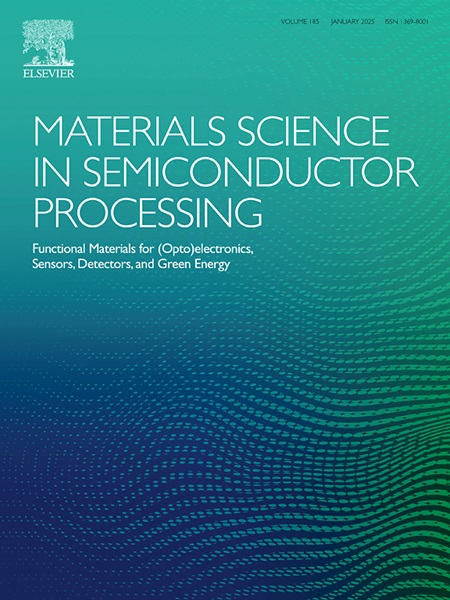Studying the effect of CuInSe2 quantum dot size on the distribution of surface defects using positron annihilation spectroscopy
IF 4.2
3区 工程技术
Q2 ENGINEERING, ELECTRICAL & ELECTRONIC
引用次数: 0
Abstract
In this work, chalcopyrite CuInSe2 (CIS) quantum dots (QDs) with an average size of 3.3 and 7.6 nm as well as CIS nanoparticles (NPs) with an average size of 11.7 nm were synthesized using a hot injection method to study the relationship between particle size and surface defect density. X-ray diffraction (XRD), Raman spectroscopy, transmission electron microscopy (TEM), and UV–Vis spectroscopy were used to characterize the synthesized samples. The UV–Vis absorption spectra reveal that by changing the size of the CIS particles, the band gap energy of the CIS particles can be precisely tuned. Furthermore, the dependence of surface defect density on particle size was explored using positron annihilation spectroscopy (PAS). The measured values of the lifetime component τ2 related to positrons annihilating mainly at the surfaces of the 3.3 and 7.6 nm CIS QDs samples were found to be 428.3 ± 1.0 and 426.3 ± 1.8 ps, respectively. On the other hand, the τ2 value for 11.7 nm CIS NPs is 376.6 ± 1.1 ps. These τ2 values are higher than those of positrons annihilated at vacancy defects in CIS nanocrystals due to the relatively large contribution of positrons annihilated at surface defects of CIS QDs. The results of correlation studies reveal that the dependence of the size and concentration of surface defects on the size of CIS particles is inverse.
利用正电子湮没光谱研究CuInSe2量子点尺寸对表面缺陷分布的影响
本文采用热注射法合成了平均尺寸为3.3和7.6 nm的黄铜矿CuInSe2 (CIS)量子点(QDs)和平均尺寸为11.7 nm的CIS纳米粒子(NPs),研究了粒径与表面缺陷密度的关系。利用x射线衍射(XRD)、拉曼光谱(Raman spectroscopy)、透射电子显微镜(TEM)和紫外可见光谱(UV-Vis spectroscopy)对合成的样品进行了表征。紫外可见吸收光谱表明,通过改变CIS粒子的尺寸,可以精确地调谐CIS粒子的带隙能量。此外,利用正电子湮没光谱(PAS)探讨了表面缺陷密度与颗粒尺寸的关系。在3.3 nm和7.6 nm的CIS量子点样品中,与正电子湮灭相关的寿命分量τ2的测量值分别为428.3±1.0和426.3±1.8 ps。另一方面,11.7 nm的CIS量子点的τ2值为376.6±1.1 ps,由于CIS量子点表面缺陷处湮灭的正电子贡献较大,因此该τ2值高于CIS纳米晶体中空位缺陷处湮灭的正电子。相关研究结果表明,表面缺陷的大小和浓度与CIS颗粒的大小呈反比关系。
本文章由计算机程序翻译,如有差异,请以英文原文为准。
求助全文
约1分钟内获得全文
求助全文
来源期刊

Materials Science in Semiconductor Processing
工程技术-材料科学:综合
CiteScore
8.00
自引率
4.90%
发文量
780
审稿时长
42 days
期刊介绍:
Materials Science in Semiconductor Processing provides a unique forum for the discussion of novel processing, applications and theoretical studies of functional materials and devices for (opto)electronics, sensors, detectors, biotechnology and green energy.
Each issue will aim to provide a snapshot of current insights, new achievements, breakthroughs and future trends in such diverse fields as microelectronics, energy conversion and storage, communications, biotechnology, (photo)catalysis, nano- and thin-film technology, hybrid and composite materials, chemical processing, vapor-phase deposition, device fabrication, and modelling, which are the backbone of advanced semiconductor processing and applications.
Coverage will include: advanced lithography for submicron devices; etching and related topics; ion implantation; damage evolution and related issues; plasma and thermal CVD; rapid thermal processing; advanced metallization and interconnect schemes; thin dielectric layers, oxidation; sol-gel processing; chemical bath and (electro)chemical deposition; compound semiconductor processing; new non-oxide materials and their applications; (macro)molecular and hybrid materials; molecular dynamics, ab-initio methods, Monte Carlo, etc.; new materials and processes for discrete and integrated circuits; magnetic materials and spintronics; heterostructures and quantum devices; engineering of the electrical and optical properties of semiconductors; crystal growth mechanisms; reliability, defect density, intrinsic impurities and defects.
 求助内容:
求助内容: 应助结果提醒方式:
应助结果提醒方式:


